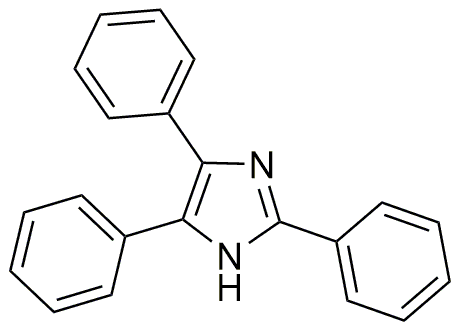2,4,5-Triphenylimidazole is widely utilized in research focused on:
- Photovoltaic Applications: This compound is used in the development of organic solar cells, enhancing their efficiency by acting as a light-absorbing material.
- Chemical Sensors: It serves as a key component in chemical sensors, particularly for detecting environmental pollutants, due to its ability to interact selectively with specific substances.
- Pharmaceutical Development: Researchers leverage its properties in drug formulation, particularly in designing compounds that target specific biological pathways, improving therapeutic efficacy.
- Polymer Chemistry: It is incorporated into polymer matrices to improve thermal stability and mechanical properties, making it valuable in materials science.
- Fluorescent Dyes: The compound is utilized in creating fluorescent dyes for biological imaging, aiding in the visualization of cellular processes in research settings.
Información general
Propiedades
Seguridad y normativas
Aplicaciones
2,4,5-Triphenylimidazole is widely utilized in research focused on:
- Photovoltaic Applications: This compound is used in the development of organic solar cells, enhancing their efficiency by acting as a light-absorbing material.
- Chemical Sensors: It serves as a key component in chemical sensors, particularly for detecting environmental pollutants, due to its ability to interact selectively with specific substances.
- Pharmaceutical Development: Researchers leverage its properties in drug formulation, particularly in designing compounds that target specific biological pathways, improving therapeutic efficacy.
- Polymer Chemistry: It is incorporated into polymer matrices to improve thermal stability and mechanical properties, making it valuable in materials science.
- Fluorescent Dyes: The compound is utilized in creating fluorescent dyes for biological imaging, aiding in the visualization of cellular processes in research settings.
Documentos
Hojas de datos de seguridad (HDS)
La SDS proporciona información de seguridad completa sobre la manipulación, el almacenamiento y la eliminación del producto.
Especificación del producto (PS)
La PS proporciona un desglose completo de las propiedades del producto, incluida la composición química, el estado físico, la pureza y los requisitos de almacenamiento. También detalla los rangos de calidad aceptables y las aplicaciones previstas del producto.
Certificados de análisis (COA)
Busque certificados de análisis (COA) ingresando el número de lote del producto. Los números de lote y de partida se pueden encontrar en la etiqueta de un producto después de las palabras "Lote" o "Lote".
Número de catálogo
Número de lote/lote
Certificados de origen (COO)
Este certificado de origen confirma el país en el que se fabricó el producto y también detalla los materiales y componentes utilizados en él y si se deriva de fuentes naturales, sintéticas u otras fuentes específicas. Este certificado puede ser necesario para cumplir con las normativas aduaneras, comerciales y regulatorias.
Número de catálogo
Número de lote/lote
Hojas de datos de seguridad (HDS)
La SDS proporciona información de seguridad completa sobre la manipulación, el almacenamiento y la eliminación del producto.
DownloadEspecificación del producto (PS)
La PS proporciona un desglose completo de las propiedades del producto, incluida la composición química, el estado físico, la pureza y los requisitos de almacenamiento. También detalla los rangos de calidad aceptables y las aplicaciones previstas del producto.
DownloadCertificados de análisis (COA)
Busque certificados de análisis (COA) ingresando el número de lote del producto. Los números de lote y de partida se pueden encontrar en la etiqueta de un producto después de las palabras "Lote" o "Lote".
Número de catálogo
Número de lote/lote
Certificados de origen (COO)
Este certificado de origen confirma el país en el que se fabricó el producto y también detalla los materiales y componentes utilizados en él y si se deriva de fuentes naturales, sintéticas u otras fuentes específicas. Este certificado puede ser necesario para cumplir con las normativas aduaneras, comerciales y regulatorias.


